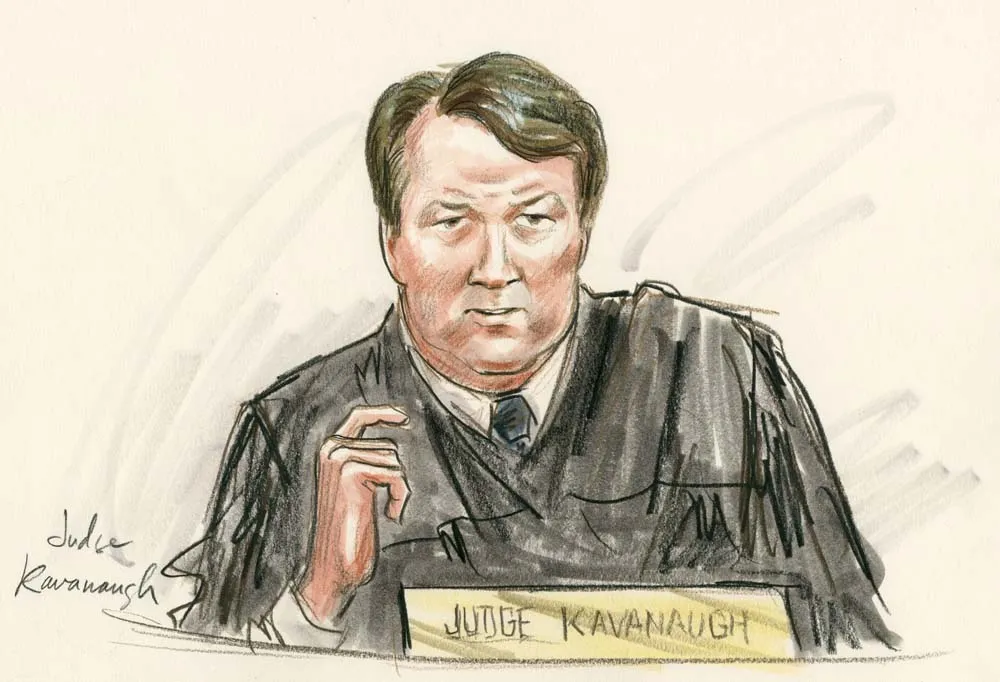Judge Kavanaugh’s record in criminal cases


By now, followers of the nomination of Judge Brett Kavanaugh of the U.S. Court of Appeals for the District of Columbia Circuit to the U.S. Supreme Court have a flood of information to consider. (Whether it is enough or not is a matter on which political partisans intensely disagree.) Further, when it comes to criminal cases, Kavanaugh’s circuit is remarkably small, both geographically (20 times smaller than Rhode Island, although denser in population) and as Orin Kerr has noted for this blog, in workload. Even the next smallest circuit has about 10 times as many criminal cases annually as the D.C. Circuit. When one also considers that federal appellate judges must follow Supreme Court precedent rather than write or consider it anew, an analysis of Kavanaugh’s relatively sparse work in criminal cases over the past 12 years yields few definitive data points.
Still, I think a review of roughly 50 published decisions (consuming over 700 pages) in which Kavanaugh has written on criminal-law-related topics can tell us a few things. I recount below what my review has yielded. But first, the statistics (for which I thank in part UC Hastings 3L Nina Gliozzo).
1. What are Kavanaugh’s criminal law statistics? A precise identification, counting and categorization of court opinions in a particular area of law is more difficult than one might first think. I feel some insecurity in the precise numbers that follow. Still, relying on Westlaw and counting generously (for example, including some Freedom of Information Act cases involving criminal-case document requests from the FBI), my review says that Kavanaugh filed written opinions in 44 criminal cases over 12 years. In 24 of these he wrote the dispositive opinion for a three-judge panel. In addition, he wrote eight panel concurrences (some in part), seven panel dissents, and five separate writings in en banc dispositions.
Kavanaugh also wrote eight opinions, some at length, in cases that involved noncitizens detained or prosecuted as “enemy combatants.” These writings are not included in my totals or this review; they will be addressed by Jonathan Hafetz in a separate post for this blog.
Finally, a number of Kavanaugh panel opinions are routine affirmances of convictions garnering no dissent even from “liberal” judges on the panel (here is a lengthy five-defendant example in which Judge Robert Wilkins was a member of the panel). This post does not discuss all 44 “criminal law” opinions, but only those that seem worthy of some note.
2. My general conclusions regarding a relatively bland body of work: The observations in this post (numbered for convenience) may surprise or disappoint some partisans. In criminal cases, Kavanaugh’s body of work is relatively straightforward and unexciting. He does not often disagree with, and never insults, his colleagues. His opinions are careful and seek to follow precedent; they take few if any legal or stylistic risks.
Meanwhile, Kavanaugh sometimes rules for defendants, occasionally in surprising ways. Indeed, the opinion of Kavanaugh’s that might be most surprising to his critics was filed in 2016’s United States v. Nwoye. Kavanaugh’s opinion, joined by Judge Harry Edwards and over the dissent of conservative Judge David Sentelle, strongly endorsed the admission of expert opinion on “battered women syndrome” and reversed a woman’s conviction for extortion.
3. Kavanaugh often finds common ground: When assigned the opinion for a three-judge panel, in 24 cases Kavanaugh’s dispositive opinions drew only a few dissents (sometimes from conservatives, see #2 above).
Of course, one can argue with the characterization of panel concurrences; in one sentencing case, for example, Judge Stephen Williams noted that if D.C. Circuit precedent were overruled, then he might disagree with Kavanaugh’s panel disposition. Yet even in that case, Chief Judge Merrick Garland, who might be viewed by some as Kavanaugh’s Democratic doppelganger, silently agreed with Kavanaugh’s opinion (more on this below); the U.S. Supreme Court later agreed as well.
Indeed, even when Kavanaugh files a concurrence in another judge’s panel disposition, his opinions generally add a point rather than dispute one, and are often complimentary. See, for example, In re Sealed Case (“I join the Court’s fine opinion.”).
4. Kavanaugh and Garland often agree: The unprecedented failure to hold a hearing on the prior administration’s Supreme Court nomination of Merrick Garland, and now the nomination of Kavanaugh by a different president, has led some to think that Kavanaugh must be Garland’s legal opposite. Most careful appellate circuit-watchers know, however, that cases that produce strong judicial disagreement, amid a large workload of criminal appeals, are uncommon. Most criminal appeals result in affirmance, and unanimity is more common than dissent.
By my count, Kavanaugh’s panel opinions were silently joined by Garland at least six times. This seems like a significant number, in light of the relatively low chances that Kavanaugh and Garland would be assigned to sit together at all within the random three-judge-panel draw from an 18-member (11 active and seven senior) court. Indeed, although I lack some confidence in the precision of my search, I found only one panel decision in which Kavanaugh and Garland disagreed (a per curiam disposition in which Garland did not claim authorship of the opinion from which Kavanaugh dissented).
Interestingly, and perhaps by way of contrast, Kavanaugh appears to have developed a bit of a pattern of disagreement with Williams. My review found as many as six cases in which Williams and Kavanaugh both wrote and disagreed with each other. I am not familiar with Williams’ body of judicial work, but given that Williams was appointed by Republican President Ronald Reagan, this disagreeing dyad might seem surprising to some.
5. Kavanaugh has a particular interest in federal sentencing and the Sentencing Guidelines: It has been said that one’s first love may be the strongest. The first published writing on criminal law by Kavanaugh that I found was a January 2007 concurrence in U.S. v. Henry, in which Kavanaugh joined Garland and Judge Karen Henderson in the reversal of a defendant’s sentence in light of the Supreme Court’s United States v. Booker decision. (Booker was an unusual case in which a five-justice majority ruled that the mandatory federal Sentencing Guidelines structure, just like that of some states, violated the Constitution’s jury trial guarantee – but then a different five-to-four majority ruled that as a remedy, the federal guidelines statute should be construed as discretionary rather than mandatory.) Kavanaugh’s opinion is quite scholarly, noting the “tensions” in Booker’s constitutional analysis.
Kavanaugh went on to manifest concerns about the nuances of federal criminal sentencing in at least eight later writings. Of particular note, he expressed misgivings in Henry, and then again in 2008 (United States v. Settles), and then a third time recently in an en banc concurrence, “about the use of acquitted conduct at sentencing,” which he wrote “seems a dubious infringement of the rights to due process and to a jury trial.”
Meanwhile, in June 2008 Kavanaugh dissented from the reversal of a sentence when he felt the district judge’s statement of reasons (in an unusual situation involving a valuable cooperator who got no jail time but then failed to comply with probationary supervision) was adequate. By contrast, in November 2008 Kavanaugh wrote for a 2-1 panel, rejecting the government’s appeal and affirming a no-jail sentence. Kavanaugh’s opinion again addressed “the big picture of current sentencing jurisprudence” and stressed the “anomalous” point that after Booker, “judges have far more … discretion in sentencing that they had pre-Booker.”
Kavanaugh’s most recent criminal law opinion, like his first, also addressed sentencing. After affirming a number of “drug-and-gun” convictions, his unanimous opinion for the panel reversed the sentence on the government’s appeal, finding that a longer mandatory minimum imprisonment term should have been imposed. Kavanaugh’s opinion was silently joined by his “liberal” colleagues Garland and Judge Sri Srinivasan.
6. Many of Kavanaugh’s rulings can be labeled “pro-defense”: Although some court-observers fear that Kavanaugh’s confirmation could drive the Supreme Court further to “the right,” I found at least eight D.C. Circuit decisions — in addition to the Nwoye “battered women syndrome” case mentioned above — in which Kavanaugh wrote to join a “pro-defendant” ruling.
In at least three of these — U.S. v. Burwell (2012), U.S. v. Williams (2016) and U.S. v. Moore (2010) — Kavanaugh endorsed strong rules governing mens rea, that is, the criminal intent that the government must prove in a criminal case to convict. For example, in Williams, Kavanaugh joined in the reversal of a murder conviction, and wrote separately “to underscore the critical importance of accurate instructions … on mens rea requirements.” In Moore, he concurred to explain at some length that “knowingly and willfully” should require “affirmative proof of the defendant’s knowledge that his or her conduct was unlawful.” Finally, in Burwell — admittedly a gun possession case with Second Amendment undertones — Kavanaugh dissented with liberal Judge David Tatel from an en banc affirmance, to strongly endorse “the presumption of mens rea” (that is, a presumption that “knowledge” must be proved) for any fact that significantly increases a defendant’s sentence.
In other cases, Kavanaugh wrote for panels that ruled for the defendant in part if not in whole. Finally, even when writing against a defense position, Kavanaugh generally uses crisp and non-judgmental language. Indeed, in a rare (for the D.C. Circuit) case involving a death-penalty defendant, Kavanaugh said this: “I believe it is essential for judicial and executive officials to ensure – particularly in death penalty cases – that claims of innocence based on newly discovered evidence are property explored.” (The case, Roth v. U.S., was a FOIA request for documents from the FBI about a capital murder investigation in Texas; Kavanaugh’s dissenting position was that precedent required a conclusion that “FOIA ordinarily is not an appropriate tool” on the facts presented.)
7. Possible Fourth Amendment misgivings? Orin Kerr’s post addresses specific Fourth Amendment decisions written by Kavanaugh. But I noticed an odd repetition in my review: On more than one occasion, Kavanaugh has begun an opinion by saying: “This is a Fourth Amendment exclusionary rule case.” Might this portend his agreement with some Supreme Court justices, that the “exclusionary rule” adopted universally in 1961 in Mapp v. Ohio should be reconsidered? (The “exclusionary rule” is a remedy that addresses Fourth Amendment violations, ordering that evidence that is the product of an unconstitutional search or seizure will not be admitted in a criminal trial of the defendant.)
8. When in dissent in criminal cases, Kavanaugh writes respectfully and without ad hominem or vitriolic language. On two occasions (both dissenting from Williams’ panel dispositions), Kavanaugh ended with “I respectfully dissent.” And he can occasionally exhibit some style. Here’s a creative first sentence in a Kavanaugh dissent: “As a lower court in a system of absolute vertical stare decisis headed by one Supreme Court, it is essential that we follow both the words and the music of Supreme Court opinions.”
Conclusion
Although Kavanaugh cannot overall be described as a criminal-law “liberal,” one might call him a “Kennedy-esque” moderate. In sum, Kavanaugh’s writings in traditional criminal-law cases seem unlikely to draw critical fire from any political direction.
Posted in Judge Kavanaugh's jurisprudence
